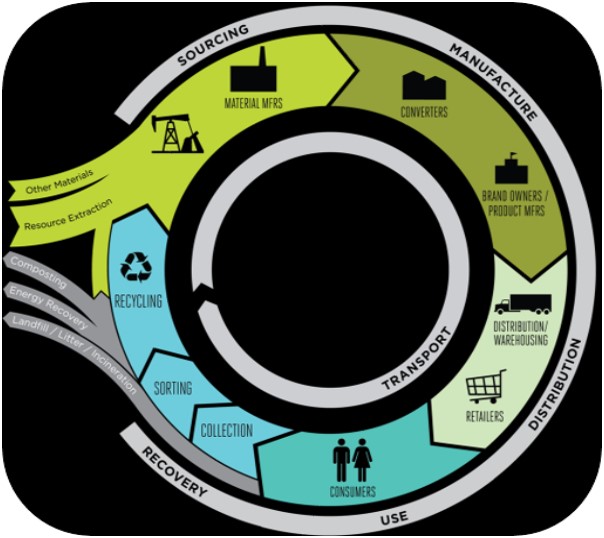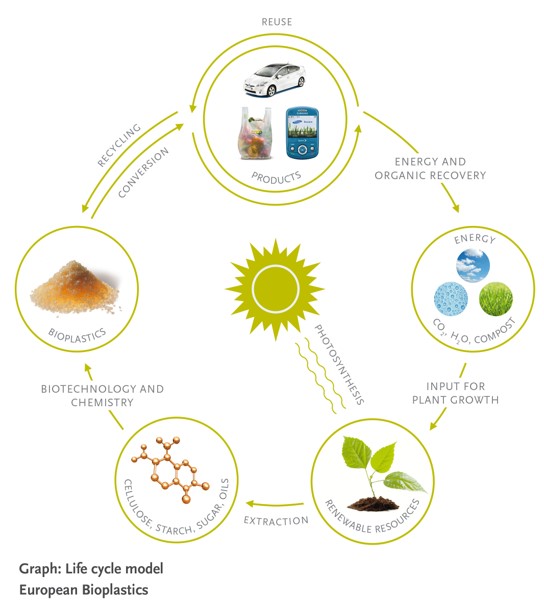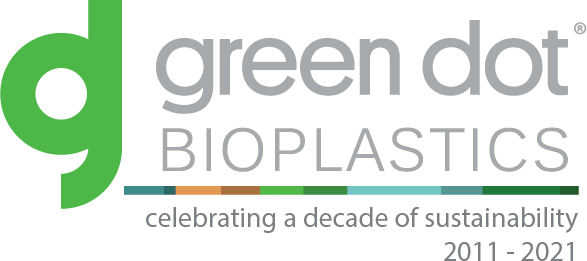What’s the matter with recycling?
Reduce, Reuse, Recycle.
We’ve been hearing this phrase and teaching it to our children for more than 40 years. It’s ingrained in our collective consciousness: if you care about the planet, then you recycle.
The petrochemical and fossil fuel industries put forth compelling facts and figures and marketing messages like this infographic showing how plastics can be recycled to the point that waste and landfill of plastics is virtually eliminated. But the reality is that after four decades of talking about the importance of recycling, more than 90% of plastic still ends up in the landfill or leaked into the environment as land and ocean waste.
Of course, we all agree we should recycle all the paper, glass, aluminum, and plastics that we can. So why hasn’t plastic recycling delivered on the promise to eliminate plastic waste?

Traditional petroleum-based plastics ideal lifecycle. Source: GreenBlue Sustainable Packaging Coalition
Why is plastic recycling a failure?
Today we use five times more plastic than we did in 1980, so clearly “reduce” hasn’t worked. “Reuse” hasn’t worked either. Forty years later, there is still virtually no “reusable” packaging for consumer goods. The “recycle” component has been highly dependent on the ability to send waste to China or SE Asia which is no longer an option thanks to cross contamination. In the best of circumstances, no more than 10% of plastic has ever been recycled.
So, why hasn’t the model worked in the past, and why is it unlikely to work in the future? Even if it was fully implemented, would it solve our plastics problems?
The simple lifecycle vision from traditional plastics manufacturers ignores some very basic issues and is therefore fundamentally flawed. Here are the key issues:
1. Plastics are not endlessly recyclable. Unlike glass and aluminum, plastics lose much of their physical strength with each heat exposure. Therefore, every time plastics are melted and formed into a shape, a film, or a foam, they lose much of their strength. Seldom will plastic manufacturers recommend using more than 25% recycled plastic in most applications – sometimes as little as 10%. And many, many, applications cannot use any recycled material at all due to regulatory and compliance issues (think food contact, FDA compliance, healthcare, food packaging).
Each lap around the recycle loop requires 50%, 75%, or even 90% new virgin fossil fuel plastic for the recycled plastic to be functional. After a few laps the recycled material is completely useless and must be bled off into the landfill or incineration stream.
2. Plastic is not plastic. “Plastic” is a generic term for hundreds, if not thousands, of different polymers. These different polymers are produced from different chemistries and have different properties which often cannot be mixed or blended. To get a useful recycled plastic material, you need a pure stream of one type of plastic, yet most packaging is composed of multiple plastic and non-plastic pieces.
For example, the simple water bottle is made of a PET bottle and a PP cap. The cap and bottle cannot be recycled together because one plastic will contaminate the other. In most municipal facilities, the cap and bottle must go through a sorting and separating process. If that process is not near-perfect the resulting recycled plastic will be contaminated. Potato chip bags and similar packages are vacuum metallized; the film is coated with metal for barrier properties which makes the plastic non-recyclable. Most soft packages and many rigid containers are comprised of multiple layers of dissimilar materials which are impossible to separate making them non-recyclable.
(Learn more about this distressing trend in packaging at As You Sow, an advocacy organization focused on corporate sustainability. Please note, this report is from 2015 and some of the companies named have taken action since then but we have yet to see measurable improvements in our global waste problem.)
3. Less than 10% of plastic is currently recycled in the US. Recycling industry proponents talk about achieving 50% recycle rates, which is still well below 85% for aluminum or 65% for paper [U.S. EPA, 2013]. This is an admirable goal, but to achieve those rates would require massive investment in collection, sorting, and recycling infrastructure. It is estimated that only 50% of Americans have access to a convenient recycling facility and we recycle less than 10% of the plastic we produce.)
Capturing another 100,000,000,000 to 200,000,000,000 pounds of plastic (still less than half of the annual plastic production) would require $billions in new collection infrastructure. Few if any government or civic entities have the resources to undertake projects of this magnitude, and the plastic industry has steadfastly refused to pay for the cost of collection, sorting, and recycling. Just as the petroleum industry has opposed carbon taxes which offset the negative impact of fossil fuels in the environment, the petroleum plastics industry expects consumers and municipalities (taxpayers) to pay the cost of collection and recycling, then give them back a purified stream of recycled plastics. Understandably, consumers balk at the cost associated with cleaning up the industry’s mess.
4. Contaminated plastics are extremely difficult to recycle. Any plastic used in food service, food packaging, fast food, institutional or commercial use, or restaurant service is contaminated with food and human contact. Outdoor applications like mulch film or lawn and garden packaging are contaminated with soil. These are examples of plastic that is nearly impossible to recycle and, in some cases, is prohibited from the recycle streams.
5. Recycling of traditional petrochemical plastics does not address greenhouse gas emissions and associated global warming. The recycle lifecycle loop still requires massive extraction of fossil fuels for raw materials and energy for production. And the lifecycle loop continues to pump fossil carbon into the atmosphere at every stage – extraction, manufacturing, transportation, recovery, and reprocessing. The environmental impact of the transportation involved in moving billions of pounds of plastic waste around is not insignificant; nor is the cost.
Are bioplastics a better option?
Bioplastics address many of the problems associated with traditional petroleum-based plastics, from production through the entire lifecycle.
At the “beginning of life”, bioplastics made with plant-based renewable raw materials are essentially carbon neutral and eliminate concerns about greenhouse gas emissions and global warming. Biobased raw materials are by definition sustainable since they are grown, not extracted.
Biobased raw materials use only biogenic, or “new carbon”, created by photosynthesis and the sequestering of atmospheric carbon. Fossil carbon, or “old carbon” is then sequestered in the ground in the form of petroleum, natural gas, or coal.
At the “end of life”, bioplastics can play a key critical role in finding alternatives to landfill and plastic waste pollution. Some bioplastics can be recycled in conventional MRFs (municipal recycle facilities) alongside traditional petrochemical plastics so new facilities or equipment are not necessary to process them.
Biodegradable plastics can be returned to nature via composting. Composting provides valuable resources to grow the next generation of plants while at the same time eliminating the cost and energy associated with collection, sorting, recycling, and reprocessing of plastic. Composting also eliminates the need for more landfill space.
Biodegradable plastics could play a huge role in allowing better waste management alternatives for food waste, garden waste, lawn debris, and agricultural waste. Placing these organic wastes in a bag or can specifically for compostables enables a mechanism to easily collect the waste and send it to a convenient composting facility without having to separate plastic food service ware or lawn & garden bags from the organic waste.

Source: European Bioplastics
What is compostable packaging?
This video was created in collaboration by PepsiCo, Milan Urban Food Policy Pact, Novamont, Seattle Public Utilities, Amsa, NFL, and Unilever.
Learn More
Blog: Leveraging biodegradable plastics to divert waste from landfills
Blog: Bioplastics role in the New Plastic Economy
Copyright © 2020 Green Dot Bioplastics, Inc. All Rights Reserved.


